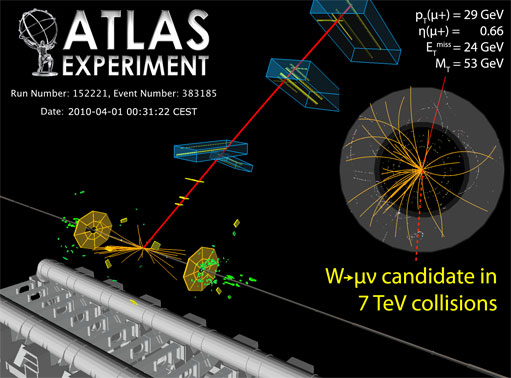
ATLAS e-News
23 February 2011
First LHC W candidates seen
13 April 2010

W candidate decaying to a muon and a neutrino
Less than a week after ATLAS saw its first high-energy collisions, two W-boson candidates were identified on Tuesday April 6th. ATLAS is the first (and so far, only) LHC experiment to have spotted W candidates, one decaying to an electron and a neutrino, and the other to a muon and a neutrino.
“For me it was amazing to go from first high-energy collisions to first W candidates in under one week,” smiles ATLAS Spokesperson, Fabiola Gianotti. “Observing Ws is the first step in our ‘rediscovery’ of the Standard Model. The fact that we arrived to the first W candidates in less than one week demonstrates the good performance of the machine and ATLAS.”
The first that many people will have heard of the first spotting (the muon event, from the early hours of April 1st) was at the ATLAS Weekly meeting on Tuesday 6th. The electron event (from early morning April 5th) was caught just before the meeting, and so didn’t quite make it in time.
Several Combined Performance groups, namely the muon, e-gamma, and jet and missing ET groups, set to work during the afternoon and evening following the Weekly meeting, checking and double-checking the robustness of the events, while the scanning team worked to produce the best possible visual representations of the candidates.
“The events themselves are very clean with gold-pated leptons, little activity in addition to the leptons, and with missing transverse energy recoiling against the leptons,” confirms Fabiola.
Observing the first W candidates is a more sophisticated achievement than what ATLAS has been doing up until now – observing the p0 and K0 peaks – because Ws are predicted to occur just once per million events.
Once everyone was sure of the events, a mail was circulated to the Collaboration on Wednesday morning, and they became public just a couple of hours later.

W candidate decaying to an electron and a neutrino
 Ceri PerkinsATLAS e-News
|